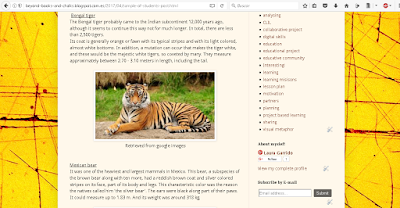Hello classmates.
Our group is formed by Goku, Lola and Florencio. We are students from 5th grade of Primary Education and we have to do a research about endangered species. We want to show you some endangered species that we have found on the internet.
ANIMALS
Giant armadillo
It is in a vulnerable situation since, it is
estimated a decrease in its population due to the loss of habitat and
hunting as usual. In 30 years, 30% of the population disappeared. Is the
largest species of armadillo that exists today. It measures between 75
and 100 cm, being able to measure the tail up to 50 cm. They weigh up to
60 kg in captivity, and in their natural environment they have data of
between 18.7 and 32.3 kg.
Retrieved from google images
Mexican wolf
There are no exemplars left living
in freedom. However, thanks to the efforts that are being made for its
recovery from individuals born and bred in captivity.
Its length is approximately 1.35 metres and its height to the cross is one 0.8 metres. Its weight varies from 27 kg to 45 kg.
It
is a beautiful animal of nocturnal habits, and that as a general rule
in the wolves they live in herds formed by 5 to 12 units, being a unique
pair that breeds, the pair alpha. They give birth to an average of 4 - 6
puppies in April or May.
Their life expectancy is 8 to 13 years in the wild and 12 to 15 years in captivity. Its coat is gray in color sometimes with a reddish tint. They feed mainly on elk, deer, peccaries, rabbits and rodents.
Retrieved from google images
Bengal tiger
The Bengal tiger probably came to
the Indian subcontinent 12,000 years ago, although it seems to continue
this way not for much longer. In total, there are less than 2,500 tigers.
Its
coat is generally orange or fawn with its typical stripes and with its
light colored, almost white bottoms. In addition, a mutation can occur
that makes the tiger white, and these would be the majestic white
tigers, so coveted by many. They measure approximately between 2.70 - 3.10 meters in length, including the tail.
Retrieved from google images
Mexican bear
It was one of the heaviest and largest mammals in Mexico. This
bear, a subspecies of the brown bear along with ten more, had a reddish
brown coat and silver colored stripes on its face, part of its body and
legs. This characteristic color was the reason the natives called him
'the silver bear'. The ears were black along part of their paws. It could measure up to 1.83 m. And its weight was around 318 kg.
Retrieved from google images
PLANTS
Drago de Gran Canaria (Drago of Gran Canaria)
This specie was found at the end of the 20th century on the island that gives it its name, Gran Canaria. At present, Tenerife and Gran Canaria are the only islands where the dragos subsist in the wild.
They have a very special shape that makes it distinctive. The dragos are characterized by having multiple trunks and take the form of umbrella with very dense leaves. Its maximum height is 12 meters, although being of slow growth, this can take several years.
Retrieved from google images
Manzanilla Real (Royal Chamomile)
It is born in areas where the cold and the ice predominate. It is a medicinal herb that has a lot of leaves of very small size of silver color. It is a plant that naturally creates more than 2300 meters above sea level.
Chamomile has a high percentage of essential oils and active essences that
make it ideal for digestive problems and upset stomach.
Retrieved from google images
Orquídea zueco (Orchid clog)
Also known as "Lady's Shoe". It is an orchid that has on the flower a yellow petal in the form of a clog, hence its name. It is often found in North America, Europe and Asia. In Belgium and Luxembourg it is now extinct. In Spain it only grows in the Pyrenees.
It lives in the moist forests. Its
collection for being so beautiful, has been the main factor of its
disappearance. It is the only European orchid that has a system of
pollination through an insect trap.
Retrieved from google images
All this is what we are going to explain to you in class, and to all of you from other schools through a video we are going to record.
We are looking forward carrying out the next step and that you like it a lot.
We have learnt a lot about animals and plants that are endangered and we want to share with you a question: how can we avoid eliminating some species? because this is sad.
We will propose some tips and we hope that all of you collaborate with us giving your opinion.
Bye, bye!





















